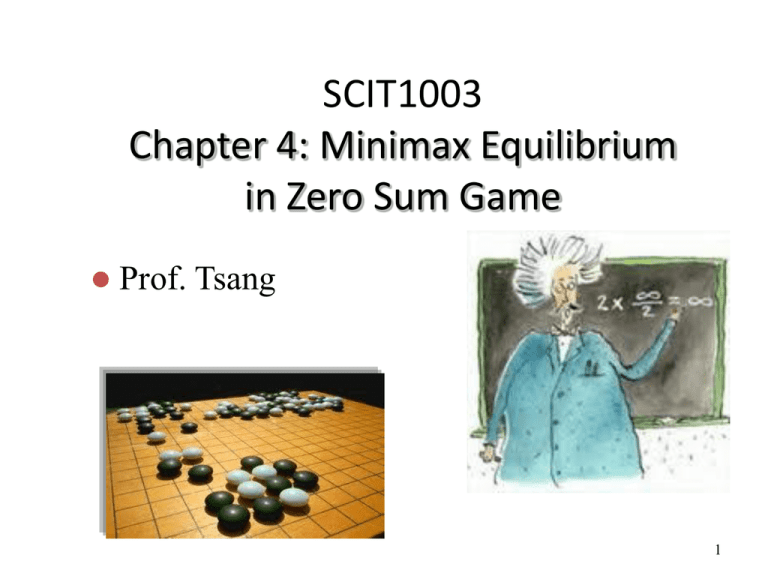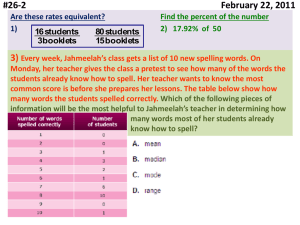Minimax Equilibrium in Zero-Sum Game, mixed strategy
advertisement

SCIT1003 Chapter 4: Minimax Equilibrium in Zero Sum Game Prof. Tsang 1 Maximin & Minimax Equilibrium in a zero-sum game • Minimax - minimizing the maximum loss (loss-ceiling, defensive) • Maximin - maximizing the minimum gain (gain-floor, offensive) • Minimax = Maximin 2 The Minimax Theorem “Every finite, two-person, zero-sum game has a rational solution in the form of a pure or mixed strategy.” John Von Neumann, 1926 For every two-person, zero-sum game with finite strategies, there exists a value V and a mixed strategy for each player, such that (a) Given player 2's strategy, the best payoff possible for player 1 is V, and (b) Given player 1's strategy, the best payoff possible for player 2 is −V. 3 Pure strategy game: Saddle point Is this a Nash Equilibrium? 1 3 MaxiMin 4 A zero-sum game with a saddle 3 MiniMax point. 4 Pure & mixed strategies A pure strategy provides a complete definition of how a player will play a game. It determines the move a player will make for any situation they could face. A mixed strategy is an assignment of a probability to each pure strategy. This allows for a player to randomly select a pure strategy. In a pure strategy a player chooses an action for sure, whereas in a mixed strategy, he chooses a probability distribution over the set of actions available to him. 5 All you need to know about Probability If E is an outcome of action, then P(E) denotes the probability that E will occur, with the following properties: 1. 0 P(E) 1 such that: If E can never occur, then P(E) = 0 If E is certain to occur, then P(E) = 1 2. The probabilities of all the possible outcomes must sum to 1 6 Mixed strategy • In some zero-sum game, there is no pure strategy solution (no Saddle point) • Play’s best way to win is mixing all possible moves together in a random (unpredictable) fashion. • E.g. Rock-Paper-Scissors 7 Mixed strategies Some games, such as Rock-Paper-Scissors, do not have a pure strategy equilibrium. In this game, if Player 1 chooses R, Player 2 should choose p, but if Player 2 chooses p, Player 1 should choose S. This continues with Player 2 choosing r in response to the choice S by Player 1, and so forth. In games like Rock-Paper-Scissors, a player will want to randomize over several actions, e.g. he/she can choose R, P & S in equal probabilities. 8 A soccer penalty shot at 12-yard left or right? p.145 payoffs are winning probability Goalie Left Left Kicker Right 42 58 Right 5 95 7 93 30 70 9 A penalty shot at 12-yard left or right? If you are the kicker, which side you use? The best chance you have is 95%. So you kick left. But the goalie anticipates that because he knows that’s your best chance. So his anticipation reduces your chance to 58%. What if you anticipate that he anticipates … so you kick right & that increase your chance to 93%. What if he anticipates that you anticipate that he anticipates … If you use a pure strategy, he always has a way to reduce you chance to win. 10 A penalty shot at 12-yard left or right? • To end this circular reasoning, you do something that the goalie cannot anticipate. • What if you mix the 2 choices randomly with 50-50 chance? • Your chance of winning is (58+93)/2 if the goalie moves to left (93+70)/2 if the goalie moves to right Is this better? 11 Kicker’s mixture p.166 graphical solution 12 Goalie’s mixture p.168 graphical solution 13 If the goalie improves his skill at saving kicks to the Right side 14 A Parking meter game (p.164) If you pay for the parking, it cause you $1. If you don’t pay for the parking and you are caught by the enforcer, the penalty is $50. Should you take the risk of not paying for the parking? How often the enforcer should patrol to keep the car drivers honest (to pay the parking fee)? 15 Parking meter game p.164 Car driver Pay Enforce Enforcer Not pay -1 1 Not enforce -50 50 -1 1 0 0 16 Mixed strategies x=probability to take action R y=probability to take action S no x y no 1-x-y 1-x-y=probability to take action P No Nash equilibrium for pure strategy 17 They have to be equal if expected payoff independent of action of player 2 18 Janken step game (Japanese RSP) p.171 19 Two-Person, Zero-Sum Games: Summary • • • • Represent outcomes as payoffs to row player Find any dominating equilibrium Evaluate row minima and column maxima If maximin=minimax, players adopt pure strategy corresponding to saddle point; choices are in stable equilibrium -- secrecy not required • If maximin minimax, find optimal mixed strategy; secrecy essential 20 Summary: Ch. 4 • • • • Look for any equilibrium Dominating Equilibrium Minimax Equilibrium Nash Equilibrium 21 Assignment 4.1 22 Assignment 4.1 23








